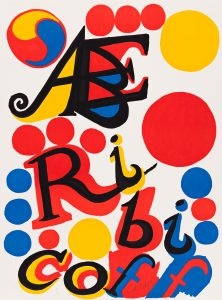By Kathleen Motes Bennewitz
While the legacy of artistic political posters lies in the larger history of graphic arts in America, the medium reached a zenith during World War I and II as a propaganda tool. In the 1960s and 70s, however, a radical watershed occurred as political artistic expression infused campaign posters. In this era of strife, conflict, and milestone change, American giants of the global art world collaborated with the Democratic Party to stir public discourse around social movements and arouse grassroot support of presidential and congressional candidates.
Alexander Calder (1898-1976)—who made Roxbury, Connecticut, his home and studio from 1933 until his death in 1976—was among those flexing their prowess and influence. As his monumental works began marking America’s cityscapes, the political opinion of the Philadelphia-born artist was gaining a public forum too. Later in life, and deeply concerned with social and political issues facing the nation, Calder began selectively employing his art—characterized by a colorful palette and floating abstract motifs—and leveraging his reputation as one of America’s most recognizable and important artists in the business of politics.
“McGovern for McGovernment”
Calder’s vehement opposition to the Vietnam War, President Richard Nixon, and the Republican Party motivated him to make strident political statements. The artist’s stance as a peace liberal was common among many of his artist and intellectual peers. In the 1960s, Calder united with likeminded notables to sign anti-draft petitions and anti-war advertisements in national newspapers.
In 1972, Calder joined a group of about one hundred high-profile artists—including Andy Warhol and Robert Rauschenberg—to support Senator George McGovern in his idealistic presidential bid against the incumbent and Republican candidate, Richard Nixon. The artists contributed artwork and limited-edition prints, many specially created for the campaign, to feature and sell in “Art for McGovern” exhibitions, gallery store fronts, and charity auctions across the country. Calder donated a mobile to the McGovern exhibition held at Pace Gallery/Sidney Janis Gallery in New York City, which sold for $24,000, to aid the Democratic party’s election effort for peace and change.
In total, Calder created five election posters for the McGovern campaign. Working with printer-publisher George Goodstadt (who was commissioned by the Democratic National Committee), they translated his vibrant gouaches into editioned posters to raise money and draw media attention. None of Calder’s campaign images portray McGovern himself, but instead play with the candidate’s name, surrounding it in arrangements of dynamic colorful forms. One iconic image, “McGovern for McGovernment,” radically moved away from the former standard of linear text and line.
Supporting Abe Ribicoff
Among Calder’s Connecticut allies and personal friends was Abraham A. Ribicoff. The son of impoverished Polish immigrants, the New Britain native enjoyed a long and admired career in public life: Connecticut state legislature; Governor of Connecticut; US Secretary of the Department of Health, Education, and Welfare; and US Senator of Connecticut. Calder—whom Ribicoff called “Sandy”—supported “Abe’s” career in Connecticut. Their political kinship also included support of McGovern, whom Ribicoff nominated as presidential candidate at the 1968 Democratic Convention in Chicago.
In 1974, Ribicoff ran for a third term in the US Senate and Calder lent his talent to his friend’s campaign. For his re-election campaign poster, Ribicoff wrote to Calder asking him to employ “a strong, simple graphic statement that reflected boldness and vigor—freshness but with dependability and a sense of direction in troubled times.” Ribicoff also requested that “Abe,” his recognizable nickname, “come through clearly at a glance.” In the resulting two posters, Calder employed stylized curvilinear and geometric shapes in vibrant primary colors to reinforce Ribicoff’s “Abe.” Printed in limited editions, Ribicoff’s campaign sold these lithographs—as well as pillows and tote bags—nationally and statewide to raise his coffers. Ribicoff won re‐election to a third term in an overwhelming victory over his Republican opponent, James H. Brannen, III.
Continuing Campaign Art
In 1974, Calder supported a second Connecticut Democrat—Anthony John “Toby” Moffett Jr. of Farmington. Moffett was making a bid for the Sixth Congressional District seat vacated by Ella Grasso as she ran for governor. For Moffett, Calder created a single poster with the lettering “Toby Moffett for Congress.” Based on a 1973 abstract work, Calder’s poster features a pair of red and blue arching forms, outlined in black, swirling towards a white circle. On August 26, 1974, the Stamford Daily Advocate reported that Moffett had unveiled Calder’s donated painting, “Red and Blue,” and anticipated raising $35,000 from the sale of the piece and related silkscreen and prints. After a primary runoff against New Britain mayor, Stanley Pac, Moffett won the seat and served in the US House of Representatives from 1975 to 1983.
Making art for political purposes did not end with Calder and the campaigns of the 1970s. For example, decades later, Shepard Fairey’s iconic Hope poster was pivotal to Barack Obama’s 2008 presidential campaign brand. Calder and his contemporaries paved the way for future artists to get involved in political campaigns and realize the power of art.
Kathleen Motes Bennewitz serves as Westport’s town curator and with Westport Public Art Collections. She has worked for art and historical museums across the country and today is also the Executive Director of The Edward Hopper House Museum & Study Center in Nyack, NY.











